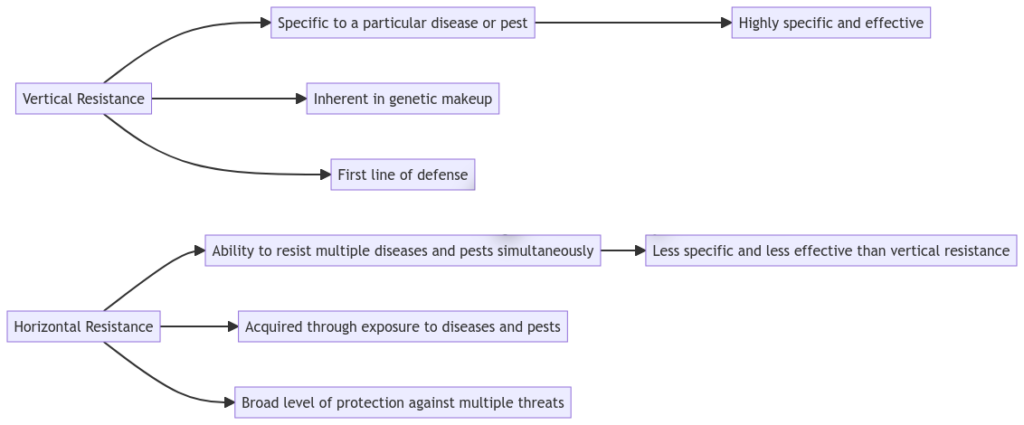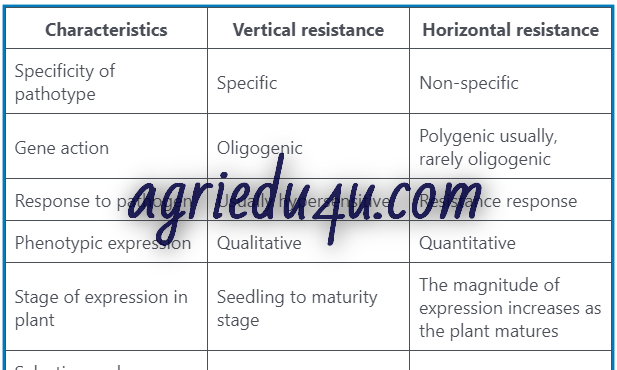Difference between vertical and horizontal resistance?
What is Vertical Resistance?
Vertical resistance is the inherent ability of a crop to resist a specific disease or pest. This resistance is built into the genetic makeup of the crop and is passed on from generation to generation. Vertical resistance is usually specific to a particular disease or pest and is often the first line of defense against these threats.
What is Horizontal Resistance?
Horizontal resistance, on the other hand, is the ability of a crop to resist multiple diseases and pests simultaneously. This type of resistance is not inherent in the genetic makeup of the crop, but is instead acquired through exposure to a variety of diseases and pests. Horizontal resistance is often less specific and less effective than vertical resistance, but it can provide a broader level of protection against multiple threats.
Difference between vertical and horizontal resistance
There are many differences between vertical and horizontal resistance which have been listed in the table below.
| Characteristics | Vertical resistance | Horizontal resistance |
|---|---|---|
| Specificity of pathotype | Specific | Non-specific |
| Gene action | Oligogenic | Polygenic usually, rarely oligogenic |
| Response to pathogen | Usually hypersensitive | Resistance response |
| Phenotypic expression | Qualitative | Quantitative |
| Stage of expression in plant | Seedling to maturity stage | The magnitude of expression increases as the plant matures |
| Selection and evaluation for trait | Easy | Relatively difficult |
| Boom and burst cycle risk | Present but not so durable | Absent |
| Host-pathogen interaction | Present | Absent |
| Need for specific resistant varieties for that strain of pathogen | Critically required | None |
| Efficiency | Very efficient against specific races | Variable efficiency can be used against all races |
| Synonyms | Major gene, race-specific, monogenic, seedling, differential, pathotype-specific resistance, specific | Polygenic, race-nonspecific, pathotype-nonspecific, uniform resistance, adult plant, field, uniform resistance |
Difference between vertical resistance and horizontal resistance table pdf

Advantages and Disadvantages of Vertical and Horizontal Resistance
Vertical resistance has the advantage of being highly specific and effective against a particular disease or pest. This makes it an excellent choice for farmers who are dealing with a specific problem and need to control it quickly and efficiently. The major disadvantage of vertical resistance is that it is often less effective against other diseases and pests and can quickly become ineffective if the target disease or pest evolves or mutates.
Horizontal resistance, on the other hand, has the advantage of providing a broader level of protection against multiple diseases and pests. This makes it an excellent choice for farmers who are dealing with a variety of threats and need to protect their crops from multiple fronts. The major disadvantage of horizontal resistance is that it is often less specific and less effective than vertical resistance, and it may not provide adequate protection against a specific disease or pest.
FAQ
Term vertical and horizontal resistance given by?
The eminent scientist Dr. Van der Plank gave the terms vertical and horizontal resistance
What is horizontal resistance also known as?
Polygenic, race-nonspecific, pathotype-nonspecific, uniform resistance, adult plant, field, uniform resistance
What is vertical resistance also known as?
Major gene, race-specific, monogenic, seedling, differential, pathotype-specific resistance, specific
Why horizontal resistance is preferred to vertical resistance?
Vertical resistance confers resistance to all races of the pathogen while horizontal resistance can be used only against a specific race of the pathogen
Choosing the Right Type of Resistance for Your Farm
The choice between vertical and horizontal resistance will depend on the specific needs and challenges of your farm. If you are dealing with a specific disease or pest, vertical resistance may be the best choice. If you are dealing with multiple threats, horizontal resistance may be a better option. It is important to work with your local extension agent or agronomist to determine the best type of resistance for your specific situation.
Conclusion
Understanding the difference between vertical and horizontal resistance is important for farmers who want to protect their crops from diseases, pests, and environmental stress. Vertical resistance is highly specific and effective against a particular disease or pest, while horizontal resistance provides a broader level of protection against multiple threats. The choice between the two will depend on the specific needs and challenges of your farm, and it is important to work with a professional to determine the best type of resistance for your situation.
Springer article for further reading Link
Difference between SDN1 and SDN2 important concept Link

